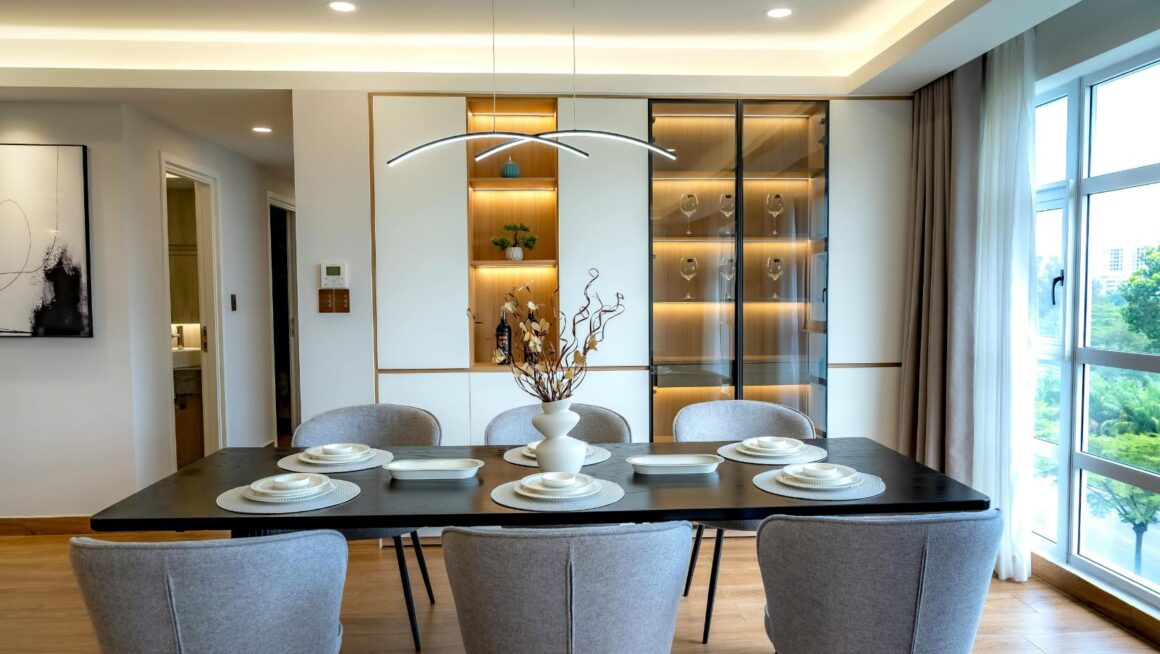
There’s something quietly confident about a round table. It doesn’t beg for attention, but it always gets it. In rooms where space feels tight, corners clash, or energy feels off, a round table resets everything. It’s the shape that brings people closer without making it obvious.
While interior design trends come and go (arches, wainscoting, muted palettes), the round dining table stays steady. It has existed in palaces, apartments, and tiny studio kitchens. It’s not about extravagance. It’s about rhythm. Every seat feels equal. Every meal feels shared.
Designers know it, homeowners sense it, and dinner guests feel it before they realize why.
The Subtle Psychology of the Circle
Shapes affect us more than we admit. Rectangles, with their corners and edges, draw invisible boundaries. They divide. Circles, on the other hand, invite. They soften. They make space feel natural, not forced.
A round wood dining table for 4 changes how a room feels because it changes how people behave. There’s no “head” of the table. No hierarchy. The conversation naturally flows. Everyone faces everyone. It’s democratic furniture, built for connection.
It’s why families linger longer after dinner. Why friends pour one more glass. Why coffee refills become stories.
Design That Actually Works for Real Homes
Interior design magazines love sprawling tables with twelve chairs and ornate centerpieces. In real life, most people don’t live in homes like that. The average dining space has limits: open concepts that merge with kitchens, condos where every inch counts, older homes with tight corners.
Round tables thrive in that reality. They carve out balance in a room that might otherwise feel boxed in. You can pull up an extra chair when guests show up unannounced, and it won’t look like a furniture traffic jam.
And for small apartments, the round shape naturally creates movement. You walk around it easily. Light flows evenly. You never feel trapped between a wall and a chair.
The Timeless Appeal of Wood
Wood brings warmth that synthetic materials can’t fake. It has weight. It has memory. When you touch it, you feel the grain, the age, the craftsmanship. A wood table grounds a space, it tells you this is where things happen. Meals. Conversations. Plans.
A round wood table in particular feels intentional. It’s not mass-produced minimalism pretending to be rustic. It’s timeless by default. Oak, maple, or walnut, each brings its own tone and texture.
You can layer it with linen or leave it bare. Either way, it stands on its own.
Why Four Seats Hit the Sweet Spot
There’s a reason the round dining has become the default choice for designers. It’s the Goldilocks size: not too small, not too large. Perfect for weeknight dinners, weekend brunches, or a quiet morning coffee when you need a place to think.
Four seats create intimacy without crowding. It’s enough space for a small gathering but still cozy enough for one or two people to enjoy daily. And when you’re not eating, it transitions seamlessly: home office, crafting spot, reading nook.
Versatility is its best feature. You can move it into a breakfast corner or a formal dining area and it never feels out of place.
How Round Dining Tables Transform Small Spaces
Small spaces live or die by proportion. A square or rectangular table can feel bulky even when it fits. A round table avoids that visual heaviness. Its shape makes a room look open and fluid.
Designers often use round tables to solve problems like awkward layouts or tight corners. The absence of sharp edges lets you angle chairs more freely, creating a softer flow from dining to living areas.
If your dining space doubles as part of the kitchen or living room, a round table creates a natural visual break without closing the room off. It defines the zone but keeps it breathable.
It’s also easier to pair with round light fixtures, pendant lamps, and circular rugs. The geometry feels cohesive, subtle, but powerful.
Materials That Matter
Wood is always the winner, but not all woods perform the same way. Oak delivers durability and visible grain. Maple brings brightness and a clean finish. Walnut adds richness and depth.
For families with kids, a sturdy hardwood with a sealed finish can withstand daily use and the occasional fork scrape. For aesthetic purists, unfinished or matte-finished wood offers that tactile authenticity that only improves with time.
When paired with minimalist chairs, the table becomes the quiet hero of the room.
Styling Without Overthinking It
The round table doesn’t need much. Its simplicity does the heavy lifting. Still, a few styling rules can help it shine.
- Centerpiece, not clutter: One statement bowl, a vase with fresh stems, or even a sculptural candleholder. Keep it focused.
- Balanced chairs: Four matching chairs always work, but mixing materials (wood and fabric, or metal and cane) adds dimension.
- Rug ratio: Choose a round rug slightly larger than the table so chairs stay grounded even when pulled out.
- Lighting alignment: A pendant or chandelier hung directly above the center reinforces symmetry.
Round tables love symmetry. Everything feels balanced without being rigid.
The Conversation Effect
Something happens around a round table that doesn’t happen anywhere else. The energy circulates. The lack of corners keeps the conversation moving. People make more eye contact. There’s less division, fewer interruptions.
For families, it means the kids speak up more. For couples, it keeps meals relaxed. For dinner parties, it turns “guests” into “participants.” Everyone gets a front-row seat.
The round table has this quiet power to make you stay longer than you planned. The kind of lingering that feels like home.
The Investment That Outlasts Trends
Trends die fast. A round wood table outlives them all. It’s the kind of furniture that can migrate with you, from your first apartment to your forever home. You can repaint the walls, swap the chairs, or even change your entire decor style. The table always fits.
Its form isn’t tied to a trend cycle. Mid-century, farmhouse, minimalist, Scandinavian, it adapts. A round wood dining table is like a good pair of jeans. It goes with everything.

That’s why furniture stores keep bringing them back season after season. Not because they’re trying to reinvent anything. Because they don’t need to.
How to Choose the Right One
If you’re ready to upgrade your dining space, a few simple rules will save you from buyer’s remorse:
- Measure first, always. Leave at least three feet of clearance around the table for chairs and movement.
- Think about the base. Pedestal bases give more legroom and visual space. Four-leg designs feel more traditional and grounded.
- Match the mood. Light woods open up a room. Dark woods create intimacy.
- Check craftsmanship. Solid joinery and real wood always win over veneers. You can feel the difference instantly.
The right table isn’t just an object. It sets the rhythm for the room.
Why Round Dining Wins Every Time
Because it’s timeless. Because it’s practical. Because it quietly transforms how you experience space.
You don’t realize how much corners interrupt flow until they’re gone. A round dining table makes every meal feel easy. It’s built for small spaces, big gatherings, and everything in between.
It’s not about being trendy. It’s about balance, connection, and design that works.
Final Thoughts
In design, the simplest shapes often hold the most power. A circle has no beginning or end. It draws people in and keeps them there.
When you sit at a round table, you notice how natural it feels. How no one is left out. How everything (conversation, energy, light) moves without interruption.
The round wood dining table isn’t just a practical choice. It’s the piece that defines a home’s atmosphere. The kind that feels right the second you sit down.






